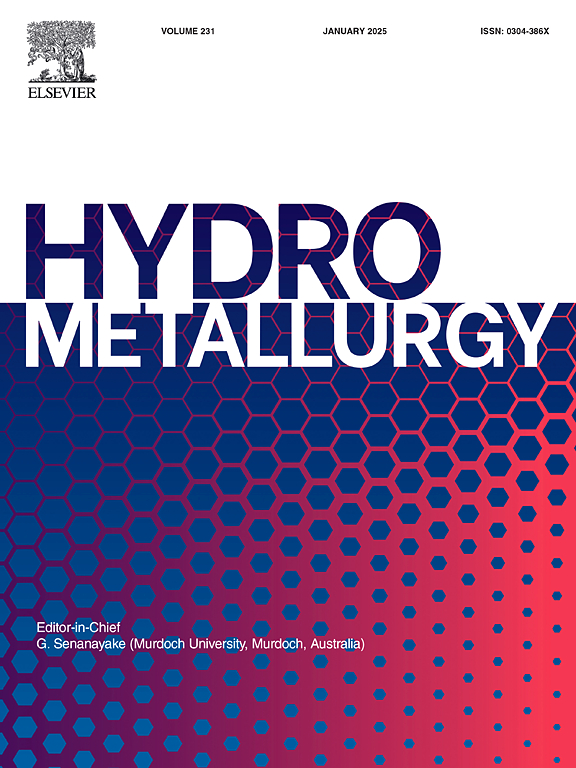Removal of fluoride ions from zinc sulfate solution by mesoporous alumina: Performance and mechanism
IF 4.8
2区 材料科学
Q1 METALLURGY & METALLURGICAL ENGINEERING
引用次数: 0
Abstract
In a flowsheet of sulfide roasting, leaching, purification and electrowinning, fluoride ions in zinc sulfate (ZnSO4) solution significantly impair the subsequent electrowinning process for zinc production. The effective removal of fluoride ions is essential for the smooth and effective operation of the entire production workflow. In this study, mesoporous alumina was synthesized using a template method and applied in fluoride ion removal from ZnSO4 solution. The maximum fluoride ion removal efficiency (94.0 %) was achieved under optimum conditions (adsorbent dosage = 2 g L−1, pH = 3.0, adsorption time = 20 min) in simulated fluoride ion solutions. Furthermore, the performance of mesoporous alumina in industrial ZnSO4 solutions was evaluated, showing a fluoride ion removal efficiency of 80.9 % and a minimal zinc loss of 0.58 %. The adsorption process of fluoride ions on mesoporous alumina was examined using adsorption kinetics and isotherms, which conformed to the pseudo-second-order kinetic model and Langmuir isotherm model. Additionally, mesoporous alumina before and after adsorption was characterized by X-ray diffraction (XRD), scanning electron microscopy (SEM), X-ray photoelectron spectroscopy (XPS), and Fourier transform infrared (FTIR). The analysis indicated that ion exchange between fluoride ions and Al-OH groups on the adsorbent led to fluoride ion removal. Moreover, the complex ions between zinc and fluoride ions in the ZnSO4 solution occupied active sites on the adsorbent surface and impeded ion exchange.
介孔氧化铝去除硫酸锌溶液中的氟离子:性能和机理
在硫化焙烧、浸出、净化和电积流程中,硫酸锌溶液中的氟离子显著影响了锌生产的后续电积过程。氟离子的有效去除对于整个生产流程的顺利有效运行至关重要。本研究采用模板法合成介孔氧化铝,并将其应用于ZnSO4溶液中除氟。在模拟氟离子溶液中,在吸附剂用量为2 g L−1、pH = 3.0、吸附时间为20 min的条件下,氟离子去除率最高,达到94.0%。此外,还对介孔氧化铝在工业硫酸锌溶液中的性能进行了评价,结果表明,介孔氧化铝的氟离子去除率为80.9%,锌的最小损失率为0.58%。采用吸附动力学和等温线研究了氟离子在介孔氧化铝上的吸附过程,符合准二级动力学模型和Langmuir等温线模型。采用x射线衍射(XRD)、扫描电镜(SEM)、x射线光电子能谱(XPS)和傅里叶变换红外(FTIR)对吸附前后介孔氧化铝进行了表征。分析表明,氟离子与吸附剂上的Al-OH基团之间的离子交换导致了氟离子的去除。此外,氯化锌溶液中锌和氟离子之间的络合离子占据了吸附剂表面的活性位点,阻碍了离子交换。
本文章由计算机程序翻译,如有差异,请以英文原文为准。
求助全文
约1分钟内获得全文
求助全文
来源期刊

Hydrometallurgy
工程技术-冶金工程
CiteScore
9.50
自引率
6.40%
发文量
144
审稿时长
3.4 months
期刊介绍:
Hydrometallurgy aims to compile studies on novel processes, process design, chemistry, modelling, control, economics and interfaces between unit operations, and to provide a forum for discussions on case histories and operational difficulties.
Topics covered include: leaching of metal values by chemical reagents or bacterial action at ambient or elevated pressures and temperatures; separation of solids from leach liquors; removal of impurities and recovery of metal values by precipitation, ion exchange, solvent extraction, gaseous reduction, cementation, electro-winning and electro-refining; pre-treatment of ores by roasting or chemical treatments such as halogenation or reduction; recycling of reagents and treatment of effluents.
 求助内容:
求助内容: 应助结果提醒方式:
应助结果提醒方式:


